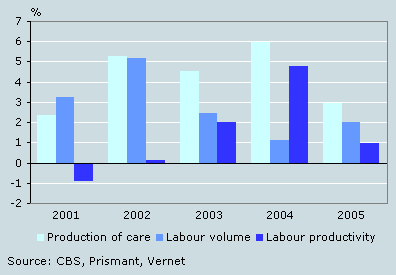Labour productivity of general hospitals lagging

Labour productivity of general hospitals was 1 percent higher in 2005 than in 2004. The strong increase in labour productivity in 2003 and 2004 did not continue in 2005.
Increase in treatments slowing down
The increase in labour productivity was smaller in 2005 because the number of treatments grew more slowly than in the preceding years, while the labour volume grew by more than in 2004.
Labour productivity growth in general hospitals

The number of treatments in general hospitals was 3 percent higher in 2005 than in 2004. In 2002–2004 total care production rose by 4.5 to 6 percent per year. This strong growth rate was connected with - among other things - agreements to reduce waiting lists for the provision of extra care. In 2005 the number of both clinical and day treatments, and outpatient treatments rose more slowly.
Growth of number of treatments in general hospitals

Labour volume did grow more quickly
The labour volume in general hospitals grew by 2 percent in 2005. In 2004 it grew by 1 percent. The number of full-time jobs was 128 thousand in 2005.
The nursing, caring and medical staff rose by 2.2 percent in 2005. The number of medical staff in the free professions hardly changed. What was noticeable was the strong rise in the number of temp agency workers and other staff contracted in, after two years of strong decrease. These included nurses and managers, but also cleaners.
Labour volume increase in general hospitals

Labour productivity needs to grow further
The increase in labour productivity is necessary to respond to the increasing demand for hospital care caused by population ageing and technological progress and to reduce the claim on the labour market. The targets for 2004–2007 agreed between the Ministry for Public Health, Welfare and Sports, hospitals and the insurance companies require efficiency in hospitals to double in 2006 and 2007 compared with 2005. The increase in labour productivity should contribute substantially to this.
Antonio Chessa and Onno van Hilten